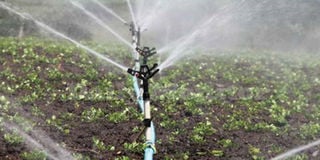Solar powered irrigation increases production

Agriculture: An irrigation system on a vegetable farm. Such systems remain just a dream for many farmers in Uganda due to high costs of installation and maintenance. PHOTO/FILE.
In the recent past, Uganda has experienced climate change and variability which impelled the government to support farmers with small scale on-farm demonstrations for solar powered irrigation systems.
Historically, the government has been more engaged in promoting large-scale irrigation for commercial farmers due to a limited understanding of the business case for small-scale irrigation.
As such, it is vital to provide information to the government and development partners on the state of the market, existing challenges and potential interventions to scale the market sustainably.
In reference to Uganda solar water pumping report 2019, the ratio of cultivated area under irrigation to Uganda’s irrigation potential is even lower than the Sub Saharan Africa average at only 0.5 per cent, whereas approximately 15 percent of the country’s surface area is covered by fresh water sources.
The land under irrigation in Uganda is almost exclusively under large-scale projects.
However, the national focus is increasingly shifting towards smaller projects, driven by a combination of demographics and rural realities.
Prior to that, an acre earned Shs2m but Jonathan Ahimibisibwe, one of the beneficiaries of the irrigation system, is now ahead of others, he gets at least Shs6m per acre per season. The system was installed last year in Katoonya village, Rubirizi District, Ahimbisibwe confirms a ramp up of production from 9 to 15 acres due to irrigation. This has enabled him to demonstrate to other farmers better farming practices and shared coffee seedlings and banana suckers for better yields.
To date, 68 solar water pumping systems have been distributed to beneficiary farmers with plans to cover all sub-counties especially in areas with long dry spells. Each solar water pumping system is valued at an average of Shs100m with a capacity of two to four cubic meters per hour, says Khadija Nakakande, head of communications National Agriculture Advisory Services (Naads).




